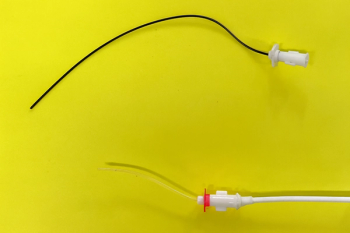
Alternative therapeutic options for management of chronic or recurring urinary tract disease in the dog and cat (Proceedings)
Although standard, mainstream, accepted therapy should always play a prominent role in treating patient problems, alternative therapeutic approaches can be valuable as adjunctive treatment options. Chronic or recurring urinary tract disease may benefit from alternative treatment options as discussed below.
Although standard, mainstream, accepted therapy should always play a prominent role in treating patient problems, alternative therapeutic approaches can be valuable as adjunctive treatment options. Chronic or recurring urinary tract disease may benefit from alternative treatment options as discussed below.
Probiotics and Prebiotics
Probiotics are live microorganisms, which when administered in adequate amounts, confer a health benefit on the host. Prebiotics are defined as non-living, nondigestible food ingredients such as oligosaccharides which beneficially affect the host by selectively stimulating the growth of and/or activating the metabolism of one or a limited number of health promoting bacteria in the intestinal tract. When a probiotic is combined with a prebiotic for the purpose of producing a synergistic effect, the mixture is referred to as a synbiotic. Probiotics with or without prebiotics appear to have the most potential for use in dogs and cats as nutritional aids in the treatment and prevention of diarrhea. However, other organ systems besides the gastrointestinal tract may also benefit from the use of such supplements.
As a general rule, in order to be effective probiotics must be stable in storage and provide large numbers of microorganisms after surviving gastric transit. In addition, the microorganisms involved must be nonpathogenic, nontoxic, non-resistant to antibiotics, and incapable of being absorbed into the bloodstream following consumption. Probiotics are frequently administered with food. The microorganisms administered are only transient residents of the GI tract. Consequently, when probiotics are indicated, they must be administered on a continuing basis to achieve the desired effect. If given concurrently with an antibiotic, the probiotic should be administered at a different time of day than the antibiotic.
One synbiotic product (Azodyl®, Vetoquinol) has been marketed as a preparation that will lower the concentration of nitrogenous waste products (especially, BUN and creatinine) in the blood of canine and feline patients with chronic kidney disese (CKD) through enteric metabolism of uremic solutes by the probiotic organisms. This action, according to the marketing company, helps prevent further kidney damage and minimizes the clinical and biochemical consequences of declining renal function. Azodyl® is administered to patients as an enteric-coated capsule which contains Enterococcus thermophilus, Lactobacillus acidophilus, and Bifidobacterium longum as probiotic organisms and oligosaccharides as prebiotic agents. Although anecdotal and/or uncontrolled reports exist of reduction in azotemia in dogs and cats, the studies on which the company's claims are primarily based are nephrectomized rat and minipig models. A clinical study of cats with a placebo-control group has been conducted, but the results, as-of-yet, have not been published. An additional concern raised about efficacy of Azodyl® lies in the fact that this product can be difficult to administer to cats in its capsule form. Consequently, the contents of the capsule are frequently sprinkled on the feline patient's food for administration, raising the question of whether the probiotic agent will be sufficiently active to be effective following GI transit.
As of this writing, although Azodyl® would not be considered harmful to canine and feline patients with CKD, its efficacy in regard to the manufacturer's claims is questionable.
It has also been suggested that probiotics may aid in the prevention of oxalate urolith formation. Studies in humans and rats have shown a decrease in urine oxalate concentration with colonization of the intestinal tract with Oxalobacter formigenes, a microorganism that facilitates degradation of oxalate in the gut and leads to decreased excretion of oxalate in the urine. The potential for use of this organism as a means of reducing oxalate urolith formation in dogs and cats has not been investigated. Furthermore, the microbe which most consistently degrades oxalate in the gut, Oxalobacter formigenes, is not contained in the common probiotic preparations used in the dog and cat.
Rhubarb
Recently the product Rubenal® by Vetoquinol has been marketed for use in slowing the progression of chronic kidney disease in dogs and cats. The product contains a medicinal rhubarb, Rheum officinale, which reportedly acts as an antifibrotic, anti-inflammatory agent and, in various lab animal species, has decreased the severity of experimental glomerulosclerosis and related proteinuria. These actions have the potential to slow down the progression of kidney disease and result in a better quality of life. Kansas State University currently has a study under way which is evaluating the effects of Rubenal® on feline patients with chronic renal disease (CRD). Preliminary results support the idea that the active ingredient does decrease proteinuria and delay progression of CRD. The pill administered is large and may be difficult to give to some cats. Few side effects have been observed but include vomiting and lethargy. Administering Rubenal® to patients with a history of calcium oxalate urolithiasis should be avoided due to the potential for increased oxalate excretion in the urine with rhubarb consumption.
Cranberry Supplement
Cranberry supplement may help prevent recurring bacterial urinary tract infection, especially infection caused by E. coli. It probably does not acidify the urine sufficiently to be effective in that way, but is thought to help destroy the biofilm that helps protect certain bacteria and allow them to attach to the uroepithelium. It is not recommended for use in patients suffering from or having a
history of oxalate uroliths since cranberry supplements may contribute to the excretion of oxalate and favor oxalate formation because of its acidifying qualities. It is best used concurrently with appropriate antibiotic therapy and/or immediately after antibiotic therapy has eradicated infection.Cranberry juice can be used in both dogs and cats, but it is bitter tasting and it is difficult to get a pet to consume enough to accomplish the desired effect. UroMAXX by Animal Nutritional Products has cranberry extract which is combined with other nutriceuticals for urinary tract health and is an easyformulation for administering one to two times daily (I would recommend twice daily dosing). Over the-counter cranberry extract can be purchased as a health supplement. Dosing is variable, but is generally recommended at approximately 10 – 20 mg/kg every 12 hours mixed with food.
Methenamine
For prevention of recurring urinary tract infection (UTI), especially of E. coli, consider the use of a urinary antiseptic once the UTI is appropriately treated with antibiotics and under control (methenamine hippurate- 500 mg/dog PO q12 hrs or 250 mg/cat PO q12 hrs). Methenamine will not be as effective with urease-producing organisms like some strains of Staph, Proteus, Enterobacter, and Pseudomonas which increase urine pH; consequently, a urinary acidifier may be required to be given concurrently to increase efficacy. The compound methenamine hippurate has hippuric acid added to help acidify the urine to aid in the hydrolysis of methenamine to formaldehyde and ammonia. A urine pH of ≤ 5.5 is optimum for breakdown of methenamine. Both formaldehyde and hippuric acid have nonspecific antibacterial activity against various gram positive and gram negative organisms. Methenamine may also have antimicrobial activity against fungal organisms. It is inadvisable to administer methenamine to patients that are pregnant, lactating, dehydrated, or experiencing renal or hepatic insufficiency. Adverse effects resulting from methenamine are primarily related to nausea, anorexia and vomiting although dysuria may be produced occasionally in response to high urine formaldehyde concentrations.
Omega-Three Fatty Acids
Fatty acid supplements have become popular as therapeutic and preventative agents over the last several years for a variety of disorders, including renal disease, cancer, osteoarthritis, hypertriglyceridemia/hypercholesterolemia, dermatitis, urogenital infections, and cardiac disease. Although many of the claims of efficacy are unproven, the potential for use as anti-inflammatory agents seems to be supported both in theory and in the clinical setting. The fatty acid supplements most commonly used are omega-3 and omega-6 fatty acids. Omega-3 fatty acid supplementsinclude eicosapentanoic acid (EPA) and docosahexaenoic acid (DHA), which are derived from oils of fish such as salmon, trout and menhaden and from flaxseed. Omega-6 fatty acid supplementsinclude linoleic acid LA) and gamma-linolenic acid (GLA), which are derived from oils of seeds such as evening primrose, black currant, and borage.
Fatty acid anti-inflammatory effect comes about through the mechanism of cell injury and the subsequent inflammatory cascade that ultimately involves the lipooxygenase and cyclooxygenase enzyme pathways. When cell membranes are injured, phospholipids in the membranes are broken down enzymatically, producing the omega-3 fatty acid , eicosapentaenoic acid, and the omega-6 fatty acid, arachidonic acid. Metabolism of eicosapentaenoic acid results in the formation of products called eicoanoids that are non-inflammatory, non-immunosuppressive, and anticoagulatory (inhibit platelet aggregation and clotting). Conversely, metabolism of arachidonic acid produces eicosanoids that are primarily pro-inflammatory, immunosuppressive, and pro-coagulatory (cause platelet aggregation and clotting). An exception to the production of inflammatory eicosanoids from arachidonic acid is the formation of the anti-inflammatory agent prostaglandin E1. In addition, the omega-6 fatty acid di-homo-gamma-linolenic acid (DGLA) produces eicosanoids that are less inflammatory than those produced from arachidonic acid. Consequently, dietary supplementation of omega-3 fatty acids and the omega- 6 fatty acid DGLA would be expected to result in increased production of non-inflammatory eicosanoids and decrease in inflammation from cell injury.
Since fish oils can have and objectionable odor and occasionally cause GI upset, flaxseed oil is sometimes used as a source of omega-3 fatty acids. Flaxseed oil does contain some omega-6 fatty acids, but is also a source of the omega-3 fatty acid alpha-linolenic acid (ALA), which can be converted to EPA and DHA. However, dogs and cats are not thought to have good ability to convert ALA to more actively non-inflammatory components, limiting its usefulness as a dietary source of beneficial omega-3 fatty acid.
As stated previously, supplementation of omega-3 fatty acids increases the production of non-inflammatory eicosanoids, including prostaglandins, which can be beneficial in reducing inflammation in renal disease as well as improving blood flow to the kidney through vasodilation. In addition, such supplementation can decrease the production of inflammatory eicosanoids. Published study data related to chronic renal disease has been most supportive of the benefits of omega-3 fatty acids in dogs although some data exists suggesting potential benefits in chronic renal failure cats fed diets supplemented with omega-3 fatty acids. Studies with chronic renal failure dogs have indicated that those dogs receiving omega-3 fatty acid supplementation had improved renal function and fewer histopathologic lesions in the kidneys. Combining antioxidants with omega-3 fatty acids may have a synergistic effect in benefiting pets affected by chronic renal disease.
Although a wide range of doses (50 – 300 mg/kg/day) can be found for omega-3 fatty acidsupplementation, (especially, EPA and DHA) doses around 100 mg/kg/day have been suggested for canine and feline patients with chronic renal disease. Many prescription diets for pets have omega-3fatty acids incorporated into the formulation, including canine and feline renal diets. Omega-6 fatty acids may be beneficial in combination with omega-3 fatty acids, but an ideal ratio for supplements has not been determined. Fish oil supplements are usually in the form of capsules or liquids. Fish oils can oxidize and become rancid, prompting manufacturers to add Vitamin E or to extract oxygen from fish oil capsules in order to prevent rancidity. At higher doses, fish oils may decrease platelet aggregation and prolong bleeding time, increase fibrinolysis, and may reduce von Willebrand factor. Gastrointestinal signs such as nausea, gas formation, and diarrhea may be associated with fish oil supplementation. Administering these supplements with food and increasing doses gradually may help limit or prevent gastrointestinal side effects.
Newsletter
From exam room tips to practice management insights, get trusted veterinary news delivered straight to your inbox—subscribe to dvm360.



